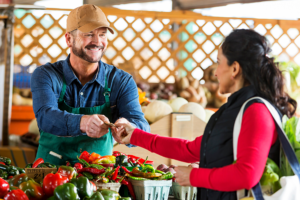Many farms regularly post mouthwatering images of harvested produce and farmers market booth layouts, and have attracted customers to their farm’s Instagram feed that want to learn more the people behind the farm and the story of their products.
Farmers are attracted to Instagram because it facilitates communication and connection with customers and fans in a spontaneous, organic way. Here are some other features and add-ons worthy of exploring that might help you further connect with customers and make it easier for them to buy from you!
- Linktree. Instagram supports just one outside URL link to your business in your profile. If you want to share a recent article about your farm without losing the link on your profile to your main website, you are stuck. Linktree solves this problem by allowing you to create multiple links from your Instagram profile – making it easy to provide links such as your main website, recent articles about your farm, and your e-commerce storefront. Linktree offers both free and paid options. The free service offers several theme options and unlimited links, while the paid service provides integration to your email marketing system and Facebook Pixel, removal of the Linktree branding, and more.
- Ads. There are two main ways to create Ads on Instagram – through the Facebook Business Manager and by promoting posts directly from the Instagram app. Creating ads via the Facebook Business Manager requires a bit more time to understand than sponsored posts, but offers some additional options for managing your ads. As we have previously written, using Facebook Pixel data to display ads to people that have visited your website could provide tremendous benefits for encouraging CSA signups, event attendance and more. These ads can even be customized to reflect the part of your website they visited. For example, if they visited your CSA signup page, Instagram can show an ad for your CSA and if they visited your farm events page, you can show an ad for your upcoming farm dinner. You will need to use the Facebook Business Manager to create and manage ads from Facebook Pixel data. Ads, including those created as promoted posts, can use demographic data or your Facebook “look alike audience” to determine the targeted audience for your ad. Most digital marketing experts recommend that you create ads using both methods and reviewing results after several weeks to determine the best targeting methodology for your needs.
- Promoted Posts. Promoted posts are just one type of ad and and will appear in post history while other ads will not. Promoted posts can include Call to Action buttons (such as Shop Now, Sign Up, or Learn More) just like ads created through the Business Manager. Promoted posts are arguably the simplest and most straightforward way to test whether Instagram ads are beneficial to your business. To promote a post, simply click the “Promote” button on any post that you wish to use for an ad and follow the steps.
 Tagged Shopping Links. Unlike ads and promoted posts which can feature a Call to Action button at the bottom of the post, tagged shopping links are appear as small shopping bag icons on the post itself – similar to the way people or brands that are featured in a photo can be tagged. Using this feature requires first setting up a Facebook Shop, and setting up each product in your Facebook shop that you want to tag in an Instagram post.
Tagged Shopping Links. Unlike ads and promoted posts which can feature a Call to Action button at the bottom of the post, tagged shopping links are appear as small shopping bag icons on the post itself – similar to the way people or brands that are featured in a photo can be tagged. Using this feature requires first setting up a Facebook Shop, and setting up each product in your Facebook shop that you want to tag in an Instagram post.
As with any marketing effort, you will need to evaluate your results and adjust your effort depending on what is working. Facebook Business Manager will track the effectiveness of your ads, including promoted posts – including average cost per click, the number of impressions, and more. You can even see some basic results on any post via the Insights link on the Instagram app. Google Analytics will also help you analyze your website traffic, including on your e-commerce storefront.
Are you using any of these tools on Instagram or others that you’d recommend? We’d love to hear about it! Contact us and tell us your story!
Register for a Demo Today!




